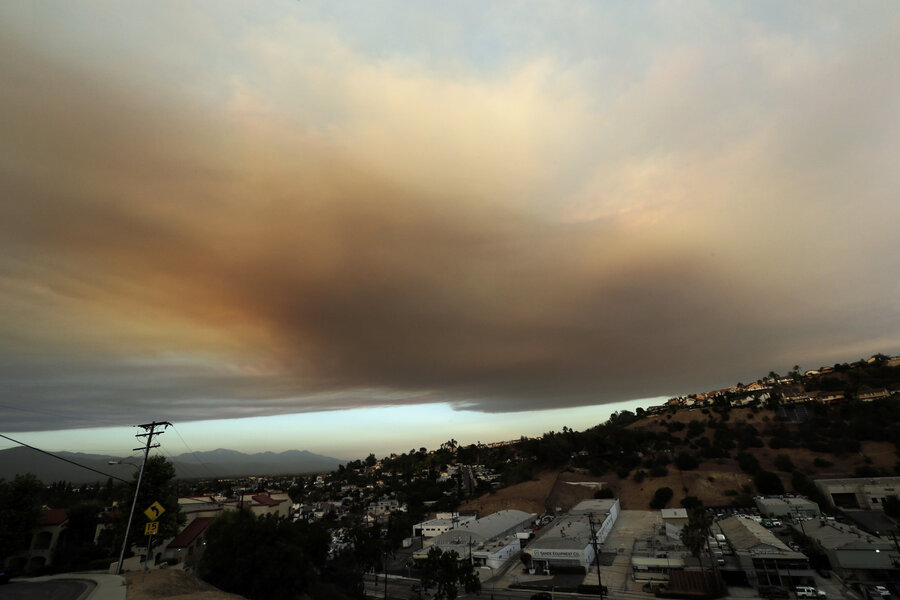Santa Clarita Sand fire: Why are California wildfires getting worse?
Loading...
Extremely dry conditions in California caused yet another fire this week, with a fire in Santa Clarita burning a path through 5,500 acres this weekend.
First reported on Friday afternoon, the fire spread rapidly, leaping from a half acre to 3,300 acres within eight hours. Wildfire experts say that this unusual fire behavior can likely be attributed to continued heat and dry conditions.
“It is unusual to see a fire grow this quickly,” fire ecology and management expert Max Moritz of the University of California, Berkeley, tells The Christian Science Monitor by phone. “There’s almost no containment and it is going to be very difficult to control. Normally you’d see these rapid growth rates with Santa Ana winds, but that’s not the case with this fire.”
Instead, Dr. Moritz attributes this fire’s unusually rapid growth rates to years of drought that have created conditions that are both dry, and hot, a trend that he says saps the life out of vegetation.
“It is probably due to the fuel moisture content,” says Moritz. “There are probably more dead plants and live fuels due to water stress.”
“It’s super-hot out there,” county fire department inspector Gustavo Medina told the Los Angeles Times. Thermometers reached 110 degrees F. in the Santa Clarita Valley. Wind speeds of up to 30 miles per hour helped the fire devour thousands of acres of dry sagebrush by Saturday.
California has already faced a number of fires this year, with the California Department of Forestry and Fire Protection reporting at least nine fires currently burning. The state is on its fifth year of drought conditions, with a state of emergency declared in 2014.
In 2015, California suffered a series of “devastating” wildfires, and the trend seems to have continued into 2016. Moritz tells the Monitor that hot and dry temperatures extend the fire season by drying out plants earlier in the year. Fires like this weekend’s Santa Clarita fire are able to spread swiftly earlier in the season than ever, before the vicious Santa Ana winds even begin to stir the flames in the fall.
“We’re going to have a critically dry and flammable situation late in the season this year,” he says. “This is not even close to the peak of the season.”
Although it may be tempting for some to blame climate change for these fires, there is much more in play, according to an article published in the Monitor earlier this month.
But climate, however critical, is only part of the problem, scientists say. A growing body of evidence suggests that other human activity and policy have at least as much impact on wildfires as climate change. To effectively address a longer and more intense wildfire season – and ensure the safety of residents in fire-prone areas – both environmental and human factors have to be taken into account in more holistic ways, they say.
That means more than just sweeping dry brush off the front porch. Though such steps are an important part of the process, officials and researchers alike are calling for a comprehensive approach to wildfires: one that incorporates fire safety and behavior in key policy decisions and legislation. Such an effort would also recognize that fire can be helpful as well as harmful and embrace fire’s place in human society.
The US Forest Service spent about half of its $5.5 billion budget last year fighting wildfires. How many of those fires could be prevented (or at least have a smaller impact) if humans took steps to avoid behaviors that can start fires - ceasing construction in hot and dry conditions, for example, or closing roads in fire prone areas?
“Human development patterns can put us at greater risk,” Moritz told the Monitor. “Human factors themselves can be as important as some of the climate variables in driving fire patterns.”
Construction and landscaping tactics can be adapted to avoid fanning the flames, he says.
And according to Monitor reporter Jessica Mendoza, some cities are doing just that. Austin, Texas, and Boulder, Colo., are just two of several cities that restrict building.
“This is going to sound cold. But if someone chooses to live in a rural area and continues to not be responsive to [fire-safety] education, sadly, the worst punishment they’re going to get is they’re going to lose their home in a fire,” Janet Upton, a fire service veteran, told the Monitor.








